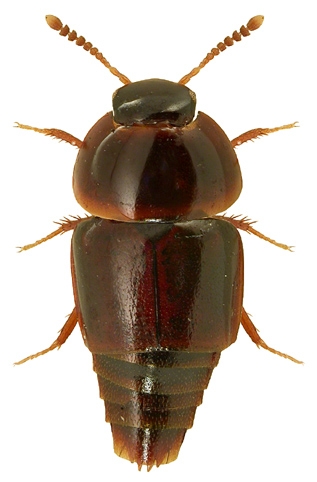Coproporus immigrans Schülke, 2006 (Col., Staphylinidae) new to the English Midlands
P.F. Whitehead
Paul F. Whitehead
Moor Leys, Little Comberton, Pershore, Worcestershire WR10 3EH email: paul@thewhiteheads.eu
Introduction
The Tachyporinae is a well-known sub-family of rove beetles often comprising shiny brightly-coloured beetles in shades of yellow orange and black and between one and 11 mm in length. Many are moisture-loving and frequently have a characteristic plan-form narrowing behind from a rounded pronotum and small head.
On 26 June 2012 at the firewood processing site known as Tiddesley Wood Barn (SO94 46 m O.D.) I had the opportunity to examine a pile of wet wood chippings, a habitat well-known for its ability to attract a variety of synanthropic and warm-stenothermic invertebrates (e.g. Whitehead, 1994). It soon became clear that this pile of wood chippings supported a population of a small uniformly brown tachyporine with significantly broad foreparts attenuated behind. A further feature of this beetle was its distinctive highly mobile abdomen which was continually elevated and rotated unlike other tachyporines seen by the writer (Fig. 1.).
Fig. 1. Coproporus sp. ♂, on the basis of its plan-form probably C. immigrans Schülke, 2006. (Image courtesy of Professor Lech Borowiec).
Discussion
The site is located amongst open pastureland and old orchards close to the edge of Tiddesley Wood near Pershore, a well-known Worcestershire Wildlife Trust woodland actively managed for its conservation interest. Tiddesley Wood Barn receives cordwood and trunkwood from many of Worcestershire Wildlife Trust's woodlands. It therefore acts as a biological assembly-point for invertebrates from VC37 some of which eventually die out; at the same time it provides instant habitat for colonists from nearby. In essence the Coleoptera fauna bears some similarity to that of a timber yards. In this case, the on-site conversion of felled trees to firewood, often by hand, creates a mosaic of wood-based habitats some of which have no analogues in nature. Having gleaned a considerable amount of biological data from this site I eventually hope to say more about it, suffice to say that the 'deadwood' invertebrate fauna of the site is quite different in composition to that of the nearby regional wet woodlands of the ancient Forest of Horewell.
A literature search implied that the tachyporines belonged to the genus Coproporus which is most usually associated with moribund trees; it may also be found associated with ants of the genus Camponotus and synanthropically amongst soft fallen fruit. Using a high-powered microscope I determined voucher specimens as Coproporus immigrans Schülke, 2006. Schülke (2006) cited no British records of C. immigrans which came too late for inclusion in his review.
Coproporus species are essentially thermophilous in warm-temperate regions. During the late 1990s observers in a number of north-west European countries, including Norway, became aware of Coproporus as a novelty. It was first recorded in Britain during 2004 (Denton, 2005) where the species is now thought to be widely established in the Home Counties (Sage, 2012) and elsewhere so that its occurrence in Worcestershire was only a matter of time. C. immigrans can be separated from the central and south European Coproporus colchicus Kraatz, 1858 by its more vaulted body and by fine details of the last abdominal tergite which, unless one is very familiar with the genus, require a microscope to resolve. Where I have found C. colchicus in southern Europe the association in that case has been with coniferous trees.
The epithet 'immigrans' is quite often employed in the binomials of adventive or tramp species which have invaded from elsewhere. On the basis of its occurrence in south-eastern Australia Schülke regards C. immigrans as of potentially Australian origin, although by the speed of its spread in north-western Europe further work may be required to confirm its range and origin. Coproporus is especially speciose in Asia (Smetana, 2004). C. immigrans is likely to turn up at other sites in Worcestershire, but unlike many tramp species has not yet been found in compost.
Acknowledgements
I thank Worcestershire Wildlife Trust and Harry Green M.B.E. for permission to visit the site. I am grateful to Dr Michael Schülke for keeping me up-to-date with his output and to Professor Lech Borowiec for the use of one of his exceptionally fine images.
References
Denton, J., 2005. The beetles of Surrey – a checklist. Surrey Wildlife Trust.
Sage, B., 2012. The first records of Coproporus immigrans Schülke and Pseudomedon obscurellus (Erichson) (Staphylinidae) for Norfolk. The Coleopterist 21:79.
Schülke, M., 2006. Drei neue Adventivarten der europäischen Staphyliniden-Fauna, mit Bemerkungen zu Coproporus colchicus Kraatz (Coleoptera, Staphylinidae, Tachyporinae). Entomologische Blätter 102:173–201.
Smetana, A, 2004. Tachyporinae, pp. 330-352 In Lobl, I. & Smetana, A. (eds), Catalogue of Palaearctic Coleoptera 2. Stenstrup: Apollo Books, 942 pp.
Whitehead, P.F., 1994. Rural breeding populations of Hypoponera punctatissima (Roger) (Hym., Formicidae) in Worcestershire. Entomologist's Monthly Magazine 130:194.
Images
Fig. 1 Coproporus. Lech Borowiec.
